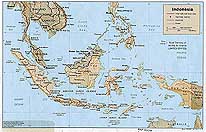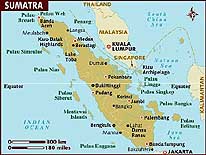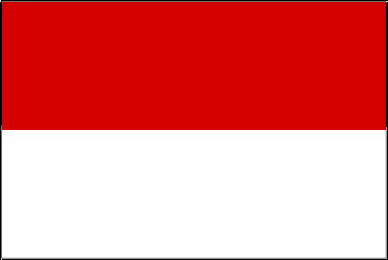-
-
- Indonesia
Map Sumatra Map
|
-
-
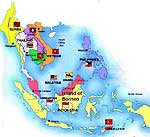
-
-
Map of Southeast Asia
-
|
-
-
-
|
- More websites from Indonesia and Timor-Leste:
|
-
- latest picture taken: April 23, 2010
- click a picture to see details
|
-
-
-
-
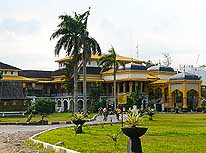
|
-
-
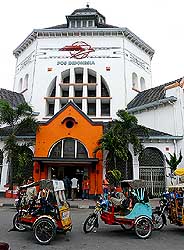
|
-
-
-
-
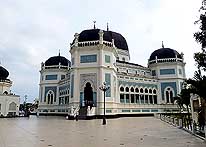
|
- 01
“Istana Maimoon“, Medan’s Sultan’s
- Palace, was built 1888. Parts of the 30
- rooms are still occupied by members of
- the Sultan’s family. The Sultan himself
- resides currently on the island of Sulawesi
|
- 02
The General Post Office
- on Merdeka Square in Medan
- is testimony of its colonial past
|
- 03
“Mesjid Raya“, the imposing
- Grand Mosque, built in rococo style,
- is the largest mosque in Medan
|
-
- “If it continues like this, I’ll do a U-turn” exclaims a frustrated Emil.
We are crawling from South Sumatra northwards with a 6 mile-speed per hour behind a steady
stream of diesel-powered trucks, discharging thick black clouds of smoke, leaving no
opportunity to overtake. But he doesn’t have to endure this strain much longer,
because shortly after Bandung Lampung, our LandCruiser makes its own decision: The
differential breaks and we have to return to Jakarta on Java.
This was on December 1st, 2006. Three years, three months and four days later, we are
nonetheless back in Sumatra. The main reason: We are planning to travel through partly
familiar ground, but also into uncharted “waters” after Central Sulawesi to Indonesian (West) Papua and proceed
from there over the land border to Vanimo in Papua New Guinea’s
province of Sandaun (West Sepik), as the 167th country. Flying in from Malaysia on board AirAsia, we land in the city of Medan in
North Sumatra on March 8th, 2010. With our “Sosial Budaya” visa that the
Indonesian Consulate in Kuala Lumpur kindly issued without asking for a sponsor, we at
least do not need an extension during the first two months and have the possibility to
extend for four additional months without having to leave the country.
|
-
-
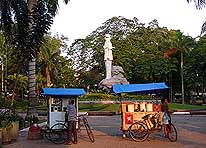
|
-
-
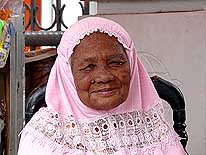
|
-
-
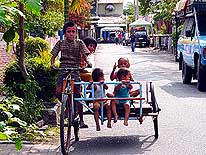
|
- 04
The lovely Ahmad Yani Park with
- its stately trees in the “aristocratic”
- part of Medan is a favorite place for
- families and students to chill out
|
- 05
The face of this grandmother
- reflects the serenity
- distinctive to Indonesia
|
- 06
Children enjoying a ride
|
-
- Immediately, we feel “at home” again, everything sounds and looks familiar:
The “Hello Mister” calls around every corner; the horrendous traffic with the
many scooters and motor trikes without mufflers squeezing in from all sides at breakneck
speed; the thick clouds of cigarette smoke of this heavy smoker nation, but especially the
omnipresent smiling faces of the people. Mr. Lim of Benline – the agent of Swire
Shipping with which our LandCruiser was transported in a container from Tonga via Kaoshiung on Taiwan and
Port Kelang in Malaysia to Belawan – sends one of his
staff to fetch us at the airport. After having settled the bill in his office (totally
US$150), he kindly gives us a lift to Belawan, Medan’s port city – about 18
miles away – where we check in at the Hotel Danau Toba International Cottage. The
communication in Indonesia being difficult without the knowledge of the local Bahasa
language, he makes also contact with Mr. Alan (Cell: +62 (0)81265070575), whose name we
kept in mind from the internet out of another travelers’ blog. Working somewhere at
Belawan’s customs he knows exactly all the necessary bureaucracy regarding the
release of a tourist vehicle. His first question is: “Do you have a Carnet?”
When we confirm, he is happy and ready to guide us through the red tape for around 20-30
US$.
|
-
-
-
-
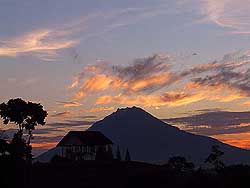
|
-
-
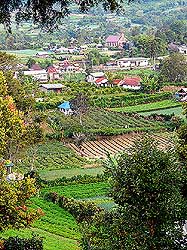
|
-
-
-
-
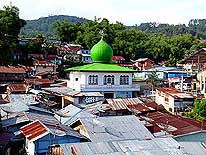
|
- 07
Sunset behind the 8’070ft. high
- „Gunung Sinabung“ in Berastagi
|
- 08
The fertile volcanic soil of the
- Karo Highlands on 4’300ft. altitude
- favors the growth of vegetables
- and fruits – here near Berastagi
|
- 09
A mosque rises above
- the modest village dwellings
- on Berastagi’s outskirts
|
-
- Exactly at 9am next morning, Emil hops on the back of his Ojek (scooter), and Alan takes
off with him to the container port 3 miles farther out. It is our 18th container clearance
and the first one, where I am not present. I am totally surprised when Emil is back at
noon already, wet like a fish from sweating, but without our car. “Is there any
problem?” I anxiously ask. “No and yes”, he explains. “The good news
is that the customs formalities are already done – another US$190 of port fees are
paid, but the bad news is that our LandCruiser refuses to move at all”. He figured
out that all the fuel drained off completely due to a small leak along the fuel lines
during the long sea journey from Tonga (luckily there was
anyway not much left in the tank). On Alan’s scooter, he drove to the gasoline
station and bought 5 gallons with one of our jerry cans. But still, it didn’t work.
He will have to deal with it in the afternoon again. What a pain: Customs formalities were
done so smoothly within three hours, and then our “travel mate” goes on strike!
|
-
-
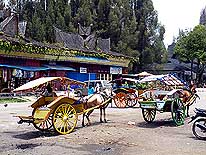
|
-
-
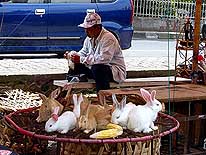
|
-
-
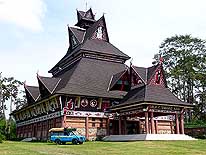
|
- 10
Nostalgic horse-drawn carriages
- are waiting in Berastagi for weekend
- guests coming from smoldering
- Medan …..
|
- 11
..... and bunnies for a new home
|
- 12
The Church St. Fransiskus Asisi
- is built in the traditional Karo Batak
- style. In North Sumatra the percentage
- of Christian and Moslem is 50:50
|
-
- Being lunch time, we head to the air-conditioned hotel restaurant and cheer up with a
really tasty ‘Chicken Maryland’. Meanwhile ‘Breaking News’ in Bahasa
– the Indonesian language – with headlines mentioning terrorists flicker
constantly on the TV screen from the local channel. What happened? Dulmatin –
Indonesia’s most wanted terrorist and mastermind behind the 2002 Bali bombing – was shot dead today by the police
in an internet cafe in the Jakarta area. And in Bandar Aceh – our first planned
destination – there is a widespread manhunt going on since February 22nd, 2010, when
police eradicated a terrorist training camp connected to Al-Qaeda. The terrorists are now
hiding in the dense jungle of Northern Sumatra and try to move South on the island’s
Westside, the most scenic part of Bandar Aceh. Are we taking a too big risk to run into
them and get kidnapped for ransom should we decide to do the trip? We still have to
consider it. Early afternoon, Emil returns to the port to solve the LandCruiser’s
fuel problem, which he found finally in the carburetor’s air supply. Immediately he
is surrounded by a crowd of around two dozen wharfies, each one with his own advice at
hand. Therefore, he is more than happy when after bleeding all the air from the fuel lines
and fixing lose screws, our “buddy” is revived again.
|
-
-
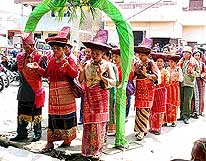
|
-
-
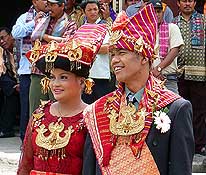
|
-
-
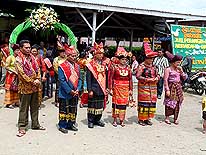
|
- A wedding of the Karo Batak tribe in Kampung Peceren at the outskirts of Berastagi
|
- 13
The wedding hosts approach
- another group of guests with
- ceremonial hand movements …..
|
- 14
..... bride and groom in their
- traditional wedding outfits …..
|
- 15
…..Bride and groom pose with
- close family members for a picture
|
-
- Long before the LandCruiser appears around the corner of our cottage, I hear its
“sound of music”, how we affectionately named its particular engine sound. What
a joy to be reunited and be mobile again. All we have to do now before starting our new
adventure is to integrate our considerable pile of luggage into the car we had taken by
plane. But tomorrow is another day – that is what also the locals say! However
exactly next morning, it starts to pour. Mid morning, luckily, the sky clears up, and at
noon we are checking out and driving through a lot of greenery to Medan, the third largest
town in Indonesia and a congested three million mega city. Because we both are still
battered from the bronchitis we both caught in Singapore
– mine having developed once more into a pneumonia – we spontaneously decide to
take a rest in a good hotel and book into the ‘Polonia’, where a lovely room
with breakfast and dinner is offered at a promotion rate of 380’000 Rupiahs, around
US$42. Across is the St. Elizabeth Hospital where, after having done an X-ray, I get
“antibiotic bombs” prescribed. Day by day I am starting to feel better. We
really hope that the rest of the year we will be free of dog bites, bronchitises and
pneumonias – enough is enough!
|
-
-
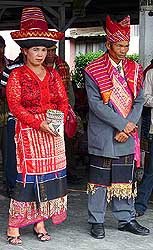
|
-
-
-
-
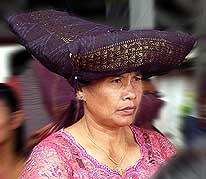
|
-
-
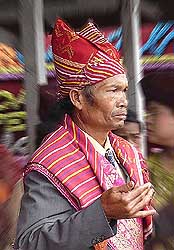
|
- 16
|
- 17
|
- 18
|
- Traditional headdress of the Karo Batak tribe. The Batak people consist of six different
tribes. They originate from Northern Thailand and Myanmar
|
-
- In downtown Medan we encounter the typical chaos of an Asian major city. However in the
“aristocratic” part with its stately trees, wide avenues and parks, where also
our hotel is situated, the atmosphere is more relaxed. Actually, there are only three
sights in town we are eager to visit: The “Istana Maimoon” – the ocher
Sultan’s Palace, built in 1888 and recently restored, with the throne exhibited in
the only room open to the public. The 30 chambers are still housing members of the
Sultan’s family. The Sultan himself resides currently on the island of Sulawesi. Then the “Grand Mosque Mesjid
Raya”, built in beautiful rococo-style, and the Chinese “Vihara Gunung
Timor” temple – said to be one of the biggest in Asia. Compared with the
richness of the temples in Taiwan however, it looks rather
modest.
|
-
-
-
-
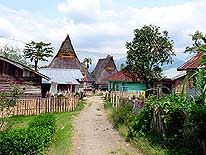
|
-
-
-
-
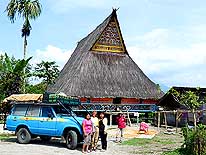
|
-
-
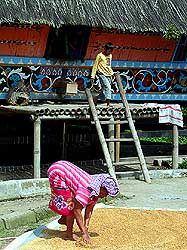
|
- 19
Traditional and new architectural
- style in the village of Lingga,
- 10 miles South of Berastagi
|
- 20
A beautiful example of a restored
- traditional Karo Batak clan house in
- Lingga. Traditional Batak houses are
- built on stilts and have thatched
- roofs resembling a boat
|
- 21
This restored Karo
- Batak Clan House in Lingga is
- occupied. 10 to 12 families fit in
|
-
- Since we knew that we were returning to Indonesia, we had the firm intention to buy a
set of new tires here in Medan, thinking that in Indonesia they are cheap. But after days
of visiting tediously one tire shop after the other, where all these guys assured
previously by phone that they do have “Radials” on stock, it turns always up
that they don’t have. They only sell “Nylon” ones, which don’t suit us
at all. Frustrated, we give up. It seems that the steel belted tire 7.50R16 is not being
produced in Indonesia and imports are extremely expensive (around US$200/piece).
Let’s hope that our really worn-out tires will at least last to Jakarta, where we
might have a better chance to get new ones.
|
-
-
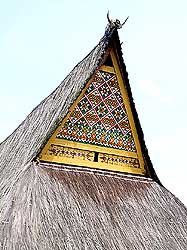
|
-
-
-
-
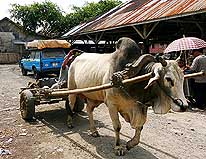
|
-
-
-
-
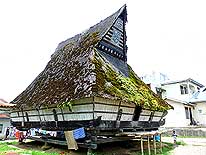
|
- 22
Mosaics of mystical
- patterns decorate the ends
- of the gable of the traditional
- Karo Batak houses
|
- 23
An ancient and a bit more modern
- mean of transport meet in Lingga
|
- 24
One of the three – unfortunately –
- decaying traditional houses in
- Kampung Peceren near Berastagi.
- The government does not take care
- of them, and the villagers do not
- have the money for restoration
|
-
- It is overcast outside and Emil has been coughing badly during the whole night –
actually not the best timing to leave behind all the comfort of the Polonia Hotel with the
rich breakfast and dinner buffet and wi-fi connection. Despite that we skipped dinner long
time ago, I enjoy each evening very much picking in all the exotic, mostly very spicy and
strange food. Not so Emil: He sticks to the good old home-style cooking, especially mine!
But regardless of all the amenities, at noon we hit the road. Listening to local advice,
we drop Bandar Aceh for the time being (who wants to risk his head!) and drive the 40
miles to the cooler Karo Batak Highlands, to Berastagi, situated at 4’300ft.
altitude. After an hour of meandering through the chaotic and polluted traffic of Medan,
finally it gets more rural and greener and then the mountains appear. And one hour later,
driving over a windy mountain road with small shops and eateries alongside and two monkeys
nibbling at a papaya hull, we reach the mountain resort.
|
-
-
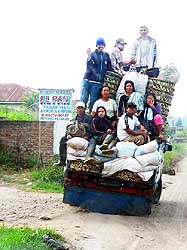
|
-
-
-
-
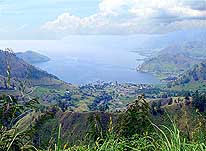
|
-
-
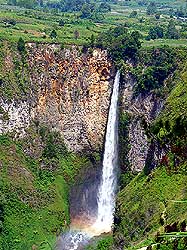
|
- 25
There is always the
- opportunity for a lift
- on Sumatra’s roads!
|
- 26
View over Lake Toba (Danau
- Toba) with the village of Tongging.
- Lake Toba with its 440 sq.mi. is
- considered as one of the big
- fresh water lakes in the world
|
- 27
15 miles South of Kabanjahe,
- at the Northern tip of Lake Toba,
- the 400ft. high Sipisopiso waterfall
- is a major tourist attraction
|
-
- Based on our Indonesian experiences back in 2007 we know that in this heavily populated
country it is practically impossible to find a nice spot to camp for the night, and the
accommodations being inexpensive, we do not even try. We drive directly to the Sibayak
Multinational Resthouse that from the setting and price seems to be OK. The lady in charge
is having lunch and the guy aside instructs us to wait until she has finished eating. A
bit strange, we think! Then there is much fuzz where we are allowed to park and where not.
And when Emil turns on the water tab at the sink in our room, there is no water. When he
tries a bit harder, the tap comes off and the water starts sputtering and inundating the
floor. We call for the caretaker. But instead of turning off immediately the main switch,
she and her guard start to blame us and get abusive. It is when the guy threatens Emil
with his fist that we are fed up, ask for refund of the money already paid and leave.
Shortly afterwards we check into the bit more expensive but far friendlier Danau Toba
International Cottages.
|
-
-
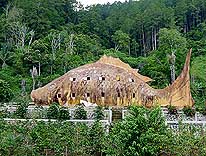
|
-
-
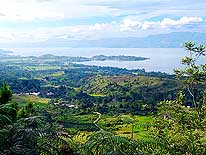
|
-
-

|
- 28
An unusual sight: A building built
- in form of a fish on the edge of the
- forest near Parapat along the
- Eastern shore of Lake Toba
|
- 29
View over Lake Toba and the
- Tuktuk-Peninsula on Samosir Island,
- shot from the hill above the
- car ferry terminal of Tomok
|
- 30
Our LandCruiser is driving
- through the “entrance gate” to the
- Tuktuk Peninsula on Samosir Island
- that has almost the size of Singapore
|
-
- In the evening, when we are sitting on the porch of our bungalow having a drink and
admiring the fertile Karo Batak valley and the volcanoes Gunung Sinabung and Sibayak, and
when behind the 8’070ft. high Gunung Sinabung the sunset begins, we are at one with
the world again. Next morning, we visit the close by Karo Batak village Kampung Peceren
with its three remaining traditional houses, but unfortunately, all three are decaying.
The government does not care to restore its history and the villagers have no money to do
it. The houses of the Karo Bataks are built on stilts and have thatched roofs resembling a
bit to a boat. This highland people are one of the six different Batak tribes, each one
with its own language, custom and culture.
|
-
-
-
-
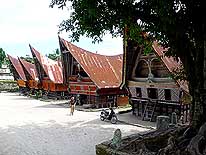
|
-
-

|
-
-
-
-
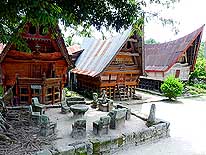
|
- 31
Traditional Toba Batak houses
- in Ambarita village,
- 2 miles North of Tuktuk .....
|
- 32
..... smiling Toba Batak
- woman at the window of
- her traditional house .....
|
- 33
..... judgement place with stone
- chairs in Ambarita village. Here the
- fate of the prisoners was decided
|
-
- Leaving the village, we spot a decorated hall with people in festive outfits. More and
more guests arrive – the ladies in wonderful dresses with laces and gold ornaments
and their particular traditional headdress. A High School English teacher tells us that a
traditional Karo Batak wedding is taking place and that it is their tradition to welcome
guests. This is how we unexpectedly are able to enjoy an exceptional ceremony. The
reception starts with a procession. To the sound of music, two groups of the wedding party
walk towards each other with little steps and slow hand movements. This is repeated
several times until the groom and the bride arrive and guide the procession into the
reception hall. In their wedding finery and with their special golden pectoral and head
attire, they present a wonderful exotic image. When the photo session of the bridal couple
with family and friends drags on, we wave good-bye.
|
-
-
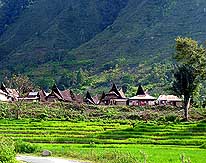
|
-
-
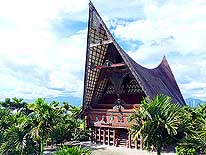
|
-
-
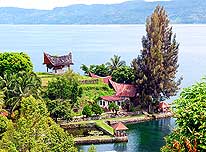
|
- 34
Rice field and a picturesque
- Toba Batak village on a hill of
- Samosir Island near Tomok
|
- 35
A huge and impressive example
- of a Toba Batak house near Tomok
- on Lake Toba’s Samosir Island
|
- 36
Timbul Peninsula Bungalows, North
- of Tuktuk. Here the accommodation
- in an own traditional Toba Batak
- house is available for 40’000 Rupees
- the night = around US$5!
|
-
- On the following day, we owe the calmness and the peace we encounter in Lingga –
approximately 10 miles South of Berastagi – to the early morning hour and the day
being a Sunday. Most people are preparing for church – the majority of the Karo
Bataks are Christians (like later the Toba Bataks too). After having registered in the
guest book in the small wooden shed and given a donation (instead of buying a souvenir),
we are free to roam around the entire village. Two of their traditional houses are
lovingly restored and people are living in it again. Especially beautiful are the mosaics
of mystical patterns that decorate the ends of the gables. Village life is awakening bit
by bit. A woman is spreading out rice on a pandanus mat, a mother is feeding her child at
the doorsteps, behind the house an ox is tightened to an archaic wooden cart. This
old-fashioned mean of transport is still widely used in rural areas what is confirmed also
by the numerous bamboo enclosures with oxen seen in the back yards. Life seems to be
unchanged since centuries.
|
-
-
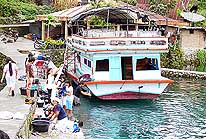
|
-
-
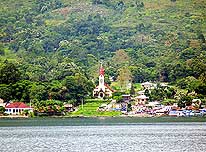
|
-
-
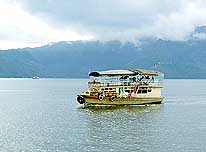
|
- 37
Passenger ferry landing in
- Tuktuk, where locals are also
- washing dishes and clothes
|
- 38
The village of Tomok on Samosir
- Island of Danau Toba is the terminal for
- the car ferry coming 5 times daily from
- Parapat, which lies on the East coast
|
- 39
The many passenger ferries
- between Samosir Island and Parapat
- on the East coast are running every
- hour. A trip lasts about half an hour
|
-
- After three days of chilling out in the freshness of the mountains, we move from
4’300ft. to 2’970ft, i.e. from Berastagi to Lake Toba. No wonder that people
indicate us that the driving time for the 75 miles will be five hours. After Kabanjahe,
the road conditions get worse. Most of the deep potholes are impossible to by-pass. We
have to stop and balance through them. At least, 15 miles after Kabanjahe, we are rewarded
by the 400ft. high Sipisopiso waterfall that tumbles from the Karo Highland down to Lake
Toba, and the view of the beautiful lake itself, currently unfortunately showing a hazy
image. Lake Toba with its 440 sq.mi. is considered to be one of the world’s big
freshwater lakes. Past mandarin and coffee plantations, wheat, cabbage and tomato fields
and shabby houses with garbage lying around everywhere, we reach Merek at the Northern end
of the lake, where we take the road along the Eastern side. From there, its condition
improves considerably and the drive through the narrow, twisting road along the
volcano’s caldera through a lovely forest is enjoyable. Now and then, we catch a
glimpse of the lake. Then it happens so fast that only afterwards I realize how narrowly
we escaped a disaster and how once more, some angels must have been watching over us! In a
narrow curve, a yellow light truck appears on our side of the road and drives straight
towards us. With an incredible presence of mind, Emil pulls into the scrub, hence avoiding
a head-on collision. What if it would have gone down a slope? Inconceivable!
|
-
-
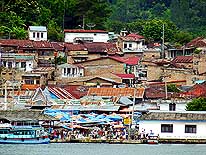
|
-
-
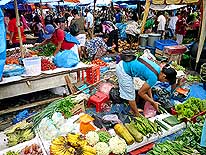
|
-
-
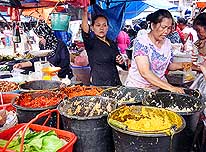
|
- 40
Parapat at the East shore of
- Lake Toba is a famous tourist
- resort since colonial times .....
|
- 41
..... the Saturday market
- is a colorful event .....
|
- 42
..... indefinable stuff in
- big buckets is for sale
|
-
- In Parapat, a popular weekend tourist destination from Medan, we reach Danau Toba, i.e.
Lake Toba. It is 2.30pm and the car ferry running to Samosir Island – an island
almost as big as Singapore, situated in the middle of the
volcano crater lake – already left. The next one is scheduled for 5.45pm –
enough time for our late lunch break. On the lake shore we spot picnic tables and –
miraculously – we are left alone, which is normally not the case in Indonesia, where
people’s interest and curiosity for strangers is huge. For 95'000 Rupiahs (=
US$10.40) for our LandCruiser including the driver and 3’500 Rupiahs (=US$0.40) for
the co-driver we sail for 45 minutes across the glassy calm lake and reach the
island’s ferry terminal of Tomok at dusk. Again and again we are amazed how extremely
cheap life can be, starting from the gasoline that costs 4’500 Rupiahs per liter (=
US$1.87/gallon). And where else in the world is an entry fee for a tourist attraction only
US$0.22, renting a scooter per day US$7.65, or US$0.75 for a half-hour-ride on a passenger
ferry, like here at Lake Toba? Incredible is also the rent of a traditional Batak house on
Samosir Island. Though modestly furnished, but still with a toilet and hot shower, it is
already available for around US$5.50/day. Advantage of this price structure take also some
retired Germans who are eager to escape the European winter climate and spend these months
in this warm climate instead.
|
-
-
-
-
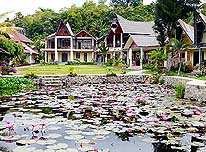
|
-
-
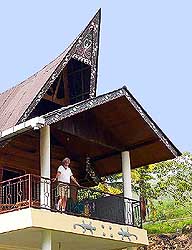
|
-
-
-
-
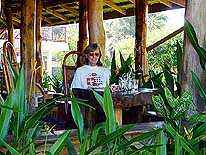
|
- 43
The „Tabo Cottages“ in
Tuktuk on
- the island of Samosir at Lake Toba are just
- how we like it: Lovely setting, immaculately
- clean, with a „homey“ and personal touch .....
|
- 44
..... Emil is enjoying the
- lovely view from the balcony
- of our spacious room .....
|
- 45
..... Liliana is sitting at the
- breakfast table. The buffet leaves
- nothing to be desired. There is even
- cheese, a rarity in Southeast Asia!
|
-
- We pay a bit more and are perfectly happy with the choice of our accommodation. The Tabo
Cottages in the tourist village of Tuktuk, lying on the small peninsula attached to
Samosir Island, are exactly what we are looking for. A really nice room with warm shower,
fridge, wi-fi and porch with hammock on the upper level of a Toba Batak house. The
cottages are in a lovely setting at the lake shore, are immaculately clean, and the
atmosphere is homey and personal. Especially beautiful is a pond with the huge pink water
lilies that unfold every morning in an incredible beauty. And the breakfast buffet –
unfortunately starting only from 8am; for early birds like us a bit late – is another
reason to smile: There is also cheese – a rarity in Asia! No wonder, the hotel is
managed by Annette, a German lady, and Anto, her Indonesian husband. She knows what her
guests, the majority being Germans, appreciate. Over Easter time, also families from the
German Embassy in Jakarta arrived to enjoy a couple of days at this idyllic place.
|
-
-
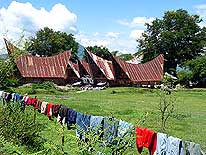
|
-
-
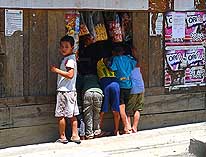
|
-
-
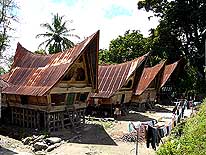
|
- 46
Simarmata – a traditional Toba
- Batak village in the North of Samosir
- Island on Lake Toba. Sadly, the once
- thatched roofs have been replaced by
- low-maintenance corrugated iron
|
- 47
Children peer through the
- window of a typical small village shop
|
- 48
At Lake Toba, many of the
- Toba Batak are still living in
- traditional villages. Here along
- the road from Tomok to Lontung
|
-
- Yes, so it happens as it always does when we feel comfortable: From one day it becomes
two, then four, then eight, then sixteen, yes – and then thirty-two. Another reason
that we are not in a hurry is that contrary to the earlier confirmation of the CEO of the
Tourist Ministry in Papua New Guinea, not all of the
required car permits for our entry from Indonesian West Papua are issued yet. Therefore,
we just enjoy our relaxing days. If Tuktuk was known 15 years ago as one of the most
popular destination on the backpacker and hippie scene, now foreign tourist life is very
little. How can businesses even survive – we ask ourselves, because the competition
is huge: Tuktuk is packed with hotels and guesthouses, cafes and restaurants still
offering “magic mushrooms”, bicycle and scooter rentals, money changers,
internet cafes and souvenir shops. We compare it with Koh Samui in Thailand.
|
-
-
-
-
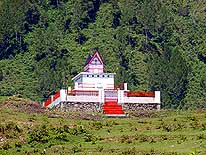
|
-
-
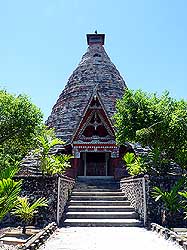
|
-
-
-
-

|
- 49
|
- 50
|
- 51
|
- Monumental tombs are widespread on Samosir Island at Lake Toba. Often they sit lonely in
the countryside, but sometimes also besides a house
|
-
- Apparently all locals own a piece of land where they grow mainly rice, but also wheat,
coffee, chili, tomatoes, cabbage, salad, avocado and other vegetables, which allows the
extended families to survive. The lady who pushes every day her pushcart packed with
vegetables through the streets to earn some money has become already a familiar sight.
Life is simple. Most of the locals still wash laundry, dishes and their hair and clean
their teeth in the lake, as they always did. In the evenings and mornings, they show up
equipped with soap, shampoo and toothbrush. But whether they do it in the lake or at home,
it does not make any difference anyway, because there is no public water supply. The grey
water from the housing is flowing also untreated into the lake. We just wonder how long it
will take until this jewel will be polluted too. The first sign is the already
considerable amount of too much algae. Scooters are the popular mean of transport on the
roads, and some of them are really noisy: Muffler removed, possibly to be recognized
easier and to be a little bit faster. How lucky we are to have sent after us only recently
ten boxes of our favorite ear plugs “Ohropax” from Switzerland!
|
-
-
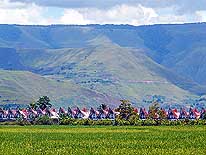
|
-
-
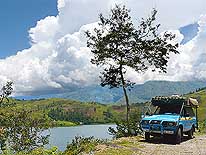
|
-
-
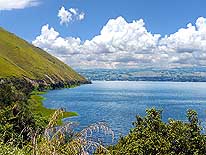
|
- 52
Wisma Sinur, a huge hotel complex
- North of Pangururan, built in Toba Batak
- architecture, nestles between a rice field
- and a mountain backdrop in the
- North of Samosir Island at Lake Toba
|
- 53
Near the village of Pangururan
- on the Southwestern side of Lake
- Toba, we pull out for lunch .....
|
- 54
..... and enjoy this charming
- sea view. In the background
- Samosir Island
|
-
- In the night of April 5th, to April 6th, 2010, something different than scooter noise
and barking dogs stirs up our blood: Suddenly, our bed shakes fiercely – an
earthquake, there is no doubt. Our watch shows 5.15am and it is still pitch dark. We press
the light switch, but the electricity is already cut. Emil grabs his torch that is always
in his reach, then the laptop and still drowsy, we rush outside. Annette, the hotel lady,
and her family are coming also outside and around other bungalows there is nervous action
too. With tense nerves, we are sitting outside for more than an hour until we
faintheartedly return to our beds while still fully alert. Fortunately no aftershocks
occur. The first news we get from Annette via her Blackberry cell phone: A quake,
magnitude 7.7, occurred in Aceh. A tsunami warning has been triggered along the West
coast. The seaquake happened at the same place as the one on Christmas 2004 that killed
170’000 people in Sumatra. Little by little more reports trickle in. There was no
Tsunami, but people were injured and there is considerable destruction of housing. Luckily
there was no loss of lives. The earthquake prone Indonesian archipelago is located on a
belt of tectonic activity girdling the Pacific Ocean, called the “Pacific Ring of
Fire”. We experienced ourselves within only four months already the second quake. The
first one, a weaker one (6.8), was on November 24th, 2009, in Tonga.
|
-
-
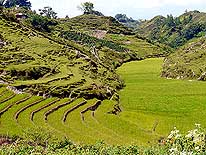
|
-
-
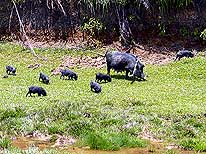
|
-
-
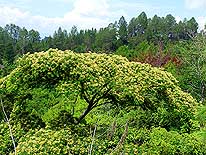
|
- 55
On the rugged highland of Samosir
- Island in Lake Toba, in the Southern
- part every inch is used for the cultivation
- of rice. Rice is planted in former lava
- flows and on terraces
|
- 56
A sow is roaming around with
- her offspring. There is enough room
- to let off steam
|
- 57
This tree with all its flowering
- beauty catches our eye while driving
- towards the South on Samosir
- Island in Lake Toba
|
-
- Next day, in historic Ambarita with its row of traditional houses North of Tuktuk, there
is another chilling site: The village looks now very peaceful; but when cannibalism
reigned, it was a different story. In the old courtyard, the village elders were sitting
300 years ago on stone chairs in a circle under an old tree and held council over the
convicts. If the death penalty was spoken, they would be dragged to the execution yard,
150ft. further on, where they were tortured, beheaded, cut in pieces, cooked and eaten.
Today, instead of humans, dogs are on the menu plan. We always asked ourselves why all the
puppies are brought up. Now we know it: They are fattened and then slaughtered. Dog meat
is sold well, two pounds (1 kilo) for 30‘000 Rupiahs (= US$3.00) – tempting at
an average daily income of US$6 to 7. The thought of it alone is upturning our stomachs.
|
-
-
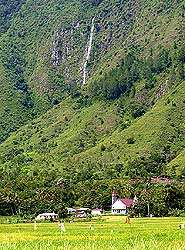
|
-
-
-
-
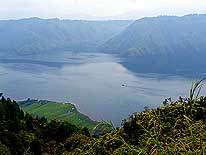
|
-
-
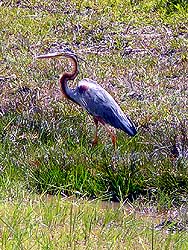
|
- 58
Peaceful picture: waterfall
- and church at the Eastern
- crater wall of Danau Toba
|
- 59
Lake Toba is meandering through
- the high crater walls for miles. From
- each view point, it shows a different face
|
- 60
A heron is on the
- lookout for a catch
|
-
- From every corner around Lake Toba, the traditional Batak houses catch our eyes.
Although they are not that traditional with their tin roofs anymore, at least their shape
is still original. As those of the Toraja people in
Sulawesi, they are inspired by the horns of the
water buffalo. Opposite to the Karo-Batak tribe further North, the Toba-Batak highland
people still live widely in traditional villages. The Bataks migrated from the foothills
of Myanmar and Thailand over l’500 years ago and they chose the fertile Northern
volcanic plateau to build their new homes, which stretches 300 miles North-South and 90
miles East-West around Lake Toba. They are farming and own many water buffaloes; we see
them everywhere, either tied to poles or wallowing freely in the mud. It is a quiet and
idyllic scenery.
|
-
-
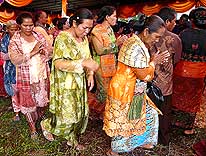
|
-
-
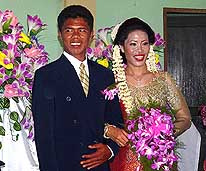
|
-
-
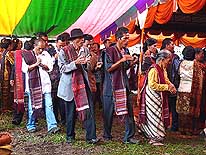
|
- A wedding of the Toba Batak tribe in Tuktuk on Samosir Island in Lake Toba
|
- 61
Women in their finest wedding
- outfit are dancing in a circle around
- the newly-weds, clapping their hands
|
- 62
The happy newly weds pose
- for pictures in one of the Catholic
- Churches in Tuktuk. Most
- Bataks are Christians
|
- 63
Also men wear a fine woven
- shawl on their shoulder. While dancing,
- they touch with it family members and
- friends – an expression of good wishes
|
-
- When after a heavy tropical rain the grey sky finally changes into deep blue,
complemented by dramatic billowing white clouds, we hop into our car and drive westwards
along the lake shore. Though the distance is only 27 miles from Tuktuk to Pangururan, it
takes us the whole day to return. The picturesque villages, the monumental, often
multi-storey tombs that sit either in lush rice fields or on a lonely hill or sometimes
also near a house are always worth a photo stop. The shapes differ too: They may be
flanked by two boats, resemble a pyramid or built in the Toba-Batak house style. In
Pangururan, we fill our tank at the only fuel station. Here the island is connected by a
small bridge to the mainland. Actually, the bridge was needed only since 1906, when the
Dutch dug a channel. This separated the previous peninsula from the main land to form an
island. We cross the bridge and continue for some time along the lovely lake shore towards
Tele before returning back to Tuktuk.
|
-
-
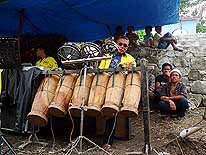
|
-
-
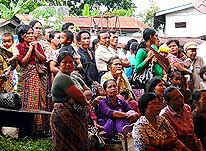
|
-
-
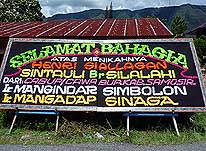
|
- 64
The wedding band: All the
- instruments are made of wood:
- flutes, the marimba-like “Garantung”
- and the small drums covered by
- drum skin at each end
|
- 65
The whole village gathers to watch
- the wedding ceremonies. They include
- traditional dances, speeches, distributing
- money and presenting the gifts to the
- newly-wed. Traditionally, they consist of beautiful mats. Each one is put around
- the shoulders of the newly-weds
|
- 66
Special congratulations are
- expressed for each event by a
- huge and colorful board, which is
- put along the street. It is made
- from artificial flowers and
- always looks attractive
|
-
- A couple of days later, we enjoy a new, but not less attractive scenery when we explore
the rugged plateau of the Southern part of Samosir Island. Lush rice fields greet us
everywhere, be it in the fertile soil of former lava flows or on accurately laid out
terraces. Apart from a white duck family swimming between the green reeds in a pond
colored by the red soil, a grey heron holding out motionless for a catch, and a sow
roaming around with her cute offspring, we hardly encounter a creature – which is
really a rarity in Indonesia. This is just how we like it. And when the views open to the
pale blue Lake Toba that is meandering for miles through the steep crater walls below us,
we are glad having made the effort of the potholed road ascent to the plateau for a third
time.
|
-
-
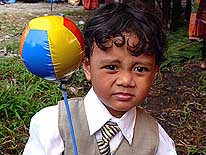
|
-
-
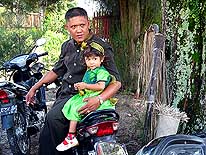
|
-
-
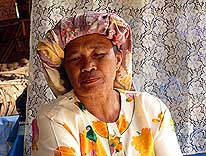
|
- 67
|
- 68
|
- 69
|
- Faces that warm our hearts!
|
-
- The days are spinning away. Soon we are already two months in Northern Sumatra and are
still waiting day by day to receive the long promised car permits from the Ministry of
Tourism to enter Papua New Guinea from Jayapura in
Indonesian West Papua. But we are put off day by day. Slowly we doubt ever getting the
papers as in the meantime we heard that between Indonesia and Papua New Guinea no mutual
agreement exists allowing the border crossing by vehicles. But we still keep hoping.
Meanwhile, we dedicate some of our time to our good old LandCruiser, which, despite of its
“Rejuvenation” in Malaysian Sarawak on the island of Borneo
four years ago, restarts to put on rust. With Epoxy and fiber glass we fill the holes.
There is no doubt that the salty sea spray of our two year’s stay in the South Pacific accelerated it, though it was sometimes
wonderful to stay directly at the beach.
|
-
-
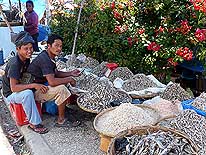
|
-
-
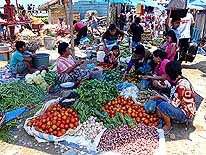
|
-
-
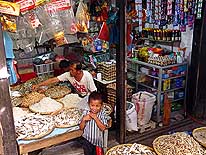
|
- Markets are always a center of attraction
|
- 70
Two lads sell dried fish
- along the road in Tomok
- on the island of Samosir
|
- 71
There is no market hall in
- Tomok. The merchandise
- is displayed on the floor
|
- 72
An incredible variety of goods:
- In Parabat’s market hall on Lake
- Toba’s Eastern shore, we discover
- this crammed shop
|
-
- On May 1st, 2010, a dull and rainy day, we leave behind one of the most beautiful lakes
and with it also the land of the Batak highland people. We are heading South towards West Sumatra, the 27th Equator-Crossing and new adventures.
|
-
-
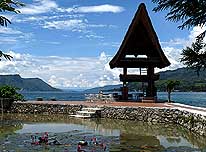
|
-
-
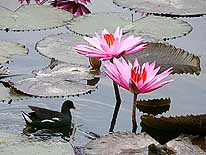
|
-
-
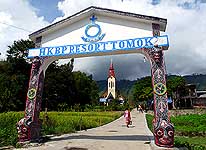
|
- 73
The traditional Batak house
- on the seashore of the “Tabo
- Cottages” on Samosir Island
- is a lovely place to relax .....
|
- 74
..... and the pink water lilies
- that unfold each morning in the
- pond are a beautiful sight
|
- 75
The beautifully adorned gate in
- Batak style in Tomok, where
- Tuktuk’s car ferry terminal on Samosir
- Island in Lake Toba is situated
|
-
|
|
To the continuation: Pictures from our
2010-Indonesian trip in West Sumatra in May and June 2010 |
|
|
- More websites from Indonesia and
Timor-Leste:
More websites from East Malaysia and
Brunei:
|
|
![]()
